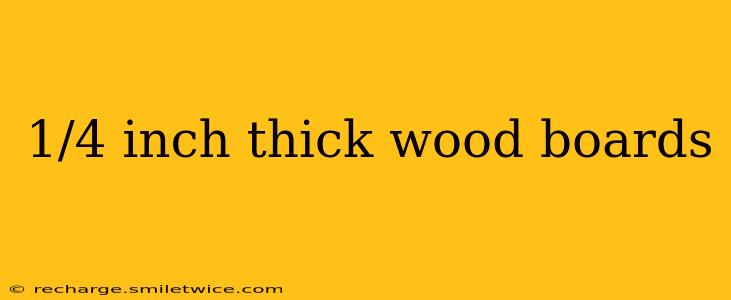Finding the right wood board for your project can feel overwhelming, especially when considering thickness. This guide focuses specifically on 1/4 inch thick wood boards, exploring their uses, advantages, disadvantages, and considerations for selection. Whether you're a seasoned woodworker or a DIY enthusiast, understanding the nuances of this thin material is crucial for success.
What are 1/4 Inch Thick Wood Boards Used For?
1/4 inch thick wood boards, often referred to as "1/4" plywood" or "thin wood sheets," offer surprising versatility despite their slender profile. Their common applications include:
-
Model making and crafting: Their flexibility and ease of cutting make them ideal for intricate designs and small-scale projects. Think miniature houses, intricate signs, and detailed models.
-
Shelving (with support): While not structurally sound enough for heavy loads on their own, they can be used for lightweight shelving when properly supported by a sturdy frame.
-
Backings and substrates: They serve as excellent backings for picture frames, decorative panels, and other projects requiring a stable, flat surface.
-
Inlays and decorative accents: Their thinness allows them to be easily inlaid into other materials, adding a decorative touch to furniture or other projects.
-
Templates and patterns: Their pliability makes them excellent for creating templates for cutting more substantial pieces of wood.
-
Cabinet and drawer bottoms: In certain applications, they can form the base of cabinets or drawers, although stronger materials are often preferred.
What Types of Wood are Available in 1/4 Inch Thickness?
While many wood types can be milled to 1/4", availability varies. You'll most commonly find:
-
Plywood: This is the most prevalent option, offering stability and affordability. Various wood veneers (like birch, oak, or maple) are used.
-
Hardboard (Masonite): A denser, less flexible option often used for backings and less demanding applications.
-
MDF (Medium-Density Fiberboard): Another engineered wood product suitable for smooth surfaces and painting, but less durable than plywood.
Are 1/4 Inch Wood Boards Strong? What are the Limitations?
The primary limitation of 1/4" wood boards is their lack of structural strength. They are not suitable for load-bearing applications or projects requiring significant durability. They're prone to bending and warping, especially without proper support. Careful planning and consideration of the project's requirements are crucial.
How Do I Choose the Right 1/4 Inch Wood Board for My Project?
Consider these factors when selecting your 1/4" wood:
-
Type of wood: Plywood generally offers the best balance of strength, stability, and affordability. MDF is suitable for painting and smooth finishes. Hardboard is durable but less versatile.
-
Intended use: Determine the demands of your project – will it need to bear weight, withstand moisture, or be subjected to rough handling? This will guide your choice of material.
-
Finish: Consider whether you'll paint, stain, or leave the wood's natural finish exposed. Some materials are better suited for certain finishes than others.
-
Cost: Prices vary depending on the type of wood and its source.
Where Can I Buy 1/4 Inch Thick Wood Boards?
1/4 inch thick wood boards are widely available at home improvement stores, lumberyards, and online retailers.
What Tools Do I Need to Work With 1/4 Inch Wood Boards?
Because of their thinness, you'll need sharp tools to avoid splintering and tearing:
-
Sharp utility knife or razor blade: For precise cutting.
-
Fine-toothed saw: A jigsaw or coping saw works well.
-
Sandpaper: For smoothing edges and surfaces.
By carefully considering the factors discussed above, you can select the perfect 1/4 inch thick wood board for your next project, ensuring a successful outcome. Remember to always prioritize safety and use appropriate tools and techniques for working with wood.
